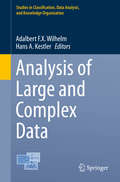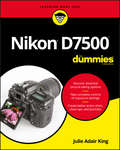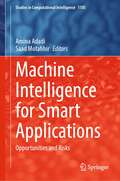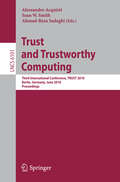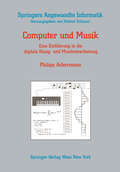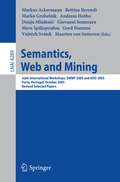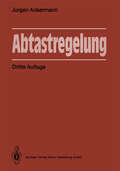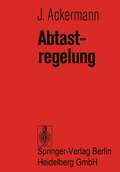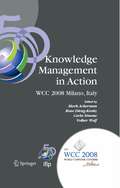- Table View
- List View
Analysis of Large and Complex Data (Studies in Classification, Data Analysis, and Knowledge Organization #0)
by Adalbert F.X. Wilhelm Hans A. KestlerThis book offers a snapshot of the state-of-the-art in classification at the interface between statistics, computer science and application fields. The contributions span a broad spectrum, from theoretical developments to practical applications; they all share a strong computational component. The topics addressed are from the following fields: Statistics and Data Analysis; Machine Learning and Knowledge Discovery; Data Analysis in Marketing; Data Analysis in Finance and Economics; Data Analysis in Medicine and the Life Sciences; Data Analysis in the Social, Behavioural, and Health Care Sciences; Data Analysis in Interdisciplinary Domains; Classification and Subject Indexing in Library and Information Science. The book presents selected papers from the Second European Conference on Data Analysis, held at Jacobs University Bremen in July 2014. This conference unites diverse researchers in the pursuit of a common topic, creating truly unique synergies in the process.
Nikon D7500 For Dummies
by Julie Adair KingYour guide to capturing that perfect shot The Nikon D7500 has created a buzz in the photography community, gaining recognition for its appealing combination of high-end features and compact size. If you’re upgrading your existing dSLR or even purchasing your very first camera, Nikon D7500 For Dummies will help you feel like a pro in no time. This book highlights the importance of understanding all of the basic features of your new camera, before diving into insights about how to take top-notch photos. You’ll learn about when and how to use flash, understand exposure, and control focus and depth of field. There is also information on taking expert action, close-up, and landscape shots, and how to access and download those photo files. Photography is a great way to capture lifelong memories, and this book makes it easy to get started. Learn photography terminology Shoot, view, and trim movies Master color controls Discover ways to customize your camera Don’t just settle for auto mode; take advantage of all the D7500’s amazing features with the help of Nikon D7500 For Dummies!
Nikon D7500 For Dummies
by Julie Adair KingYour guide to capturing that perfect shot The Nikon D7500 has created a buzz in the photography community, gaining recognition for its appealing combination of high-end features and compact size. If you’re upgrading your existing dSLR or even purchasing your very first camera, Nikon D7500 For Dummies will help you feel like a pro in no time. This book highlights the importance of understanding all of the basic features of your new camera, before diving into insights about how to take top-notch photos. You’ll learn about when and how to use flash, understand exposure, and control focus and depth of field. There is also information on taking expert action, close-up, and landscape shots, and how to access and download those photo files. Photography is a great way to capture lifelong memories, and this book makes it easy to get started. Learn photography terminology Shoot, view, and trim movies Master color controls Discover ways to customize your camera Don’t just settle for auto mode; take advantage of all the D7500’s amazing features with the help of Nikon D7500 For Dummies!
Machine Intelligence for Smart Applications: Opportunities and Risks (Studies in Computational Intelligence #1105)
by Amina Adadi Saad MotahhirThis book provides insights into recent advances in Machine Intelligence (MI) and related technologies, identifies risks and challenges that are, or could be, slowing down overall MI mainstream adoption and innovation efforts, and discusses potential solutions to address these limitations. All these aspects are explored through the lens of smart applications. The book navigates the landscape of the most recent, prominent, and impactful MI smart applications. The broad set of smart applications for MI is organized into four themes covering all areas of the economy and social life, namely (i) Smart Environment, (ii) Smart Social Living, (iii) Smart Business and Manufacturing, and (iv) Smart Government. The book examines not only present smart applications but also takes a look at how MI may potentially be applied in the future. This book is aimed at researchers and postgraduate students in applied artificial intelligence and allied technologies. The book is also valuable for practitioners, and it serves as a bridge between researchers and practitioners. It also helps connect researchers interested in MI technologies who come from different social and business disciplines and who can benefit from sharing ideas and results.
Explainable Artificial Intelligence for Intelligent Transportation Systems
by Amina Adadi Afaf BouhouteArtificial Intelligence (AI) and Machine Learning (ML) are set to revolutionize all industries, and the Intelligent Transportation Systems (ITS) field is no exception. While ML, especially deep learning models, achieve great performance in terms of accuracy, the outcomes provided are not amenable to human scrutiny and can hardly be explained. This can be very problematic, especially for systems of a safety-critical nature such as transportation systems. Explainable AI (XAI) methods have been proposed to tackle this issue by producing human interpretable representations of machine learning models while maintaining performance. These methods hold the potential to increase public acceptance and trust in AI-based ITS. FEATURES: Provides the necessary background for newcomers to the field (both academics and interested practitioners) Presents a timely snapshot of explainable and interpretable models in ITS applications Discusses ethical, societal, and legal implications of adopting XAI in the context of ITS Identifies future research directions and open problems
Explainable Artificial Intelligence for Intelligent Transportation Systems
by Amina Adadi Afaf BouhouteArtificial Intelligence (AI) and Machine Learning (ML) are set to revolutionize all industries, and the Intelligent Transportation Systems (ITS) field is no exception. While ML, especially deep learning models, achieve great performance in terms of accuracy, the outcomes provided are not amenable to human scrutiny and can hardly be explained. This can be very problematic, especially for systems of a safety-critical nature such as transportation systems. Explainable AI (XAI) methods have been proposed to tackle this issue by producing human interpretable representations of machine learning models while maintaining performance. These methods hold the potential to increase public acceptance and trust in AI-based ITS. FEATURES: Provides the necessary background for newcomers to the field (both academics and interested practitioners) Presents a timely snapshot of explainable and interpretable models in ITS applications Discusses ethical, societal, and legal implications of adopting XAI in the context of ITS Identifies future research directions and open problems
Matrix-Based Introduction to Multivariate Data Analysis
by Kohei AdachiThis is the first textbook that allows readers who may be unfamiliar with matrices to understand a variety of multivariate analysis procedures in matrix forms. By explaining which models underlie particular procedures and what objective function is optimized to fit the model to the data, it enables readers to rapidly comprehend multivariate data analysis. Arranged so that readers can intuitively grasp the purposes for which multivariate analysis procedures are used, the book also offers clear explanations of those purposes, with numerical examples preceding the mathematical descriptions.Supporting the modern matrix formulations by highlighting singular value decomposition among theorems in matrix algebra, this book is useful for undergraduate students who have already learned introductory statistics, as well as for graduate students and researchers who are not familiar with matrix-intensive formulations of multivariate data analysis.The book begins by explaining fundamental matrix operations and the matrix expressions of elementary statistics. Then, it offers an introduction to popular multivariate procedures, with each chapter featuring increasing advanced levels of matrix algebra. Further the book includes in six chapters on advanced procedures, covering advanced matrix operations and recently proposed multivariate procedures, such as sparse estimation, together with a clear explication of the differences between principal components and factor analyses solutions. In a nutshell, this book allows readers to gain an understanding of the latest developments in multivariate data science.
Matrix-Based Introduction to Multivariate Data Analysis
by Kohei AdachiThis book enables readers who may not be familiar with matrices to understand a variety of multivariate analysis procedures in matrix forms. Another feature of the book is that it emphasizes what model underlies a procedure and what objective function is optimized for fitting the model to data. The author believes that the matrix-based learning of such models and objective functions is the fastest way to comprehend multivariate data analysis. The text is arranged so that readers can intuitively capture the purposes for which multivariate analysis procedures are utilized: plain explanations of the purposes with numerical examples precede mathematical descriptions in almost every chapter. This volume is appropriate for undergraduate students who already have studied introductory statistics. Graduate students and researchers who are not familiar with matrix-intensive formulations of multivariate data analysis will also find the book useful, as it is based on modern matrix formulations with a special emphasis on singular value decomposition among theorems in matrix algebra. The book begins with an explanation of fundamental matrix operations and the matrix expressions of elementary statistics, followed by the introduction of popular multivariate procedures with advancing levels of matrix algebra chapter by chapter. This organization of the book allows readers without knowledge of matrices to deepen their understanding of multivariate data analysis.
A Software Process Model Handbook for Incorporating People's Capabilities
by Silvia T. Acuna Natalia Juristo Ana Maria Moreno Alicia MonA Software Process Model Handbook for Incorporating People's Capabilities offers the most advanced approach to date, empirically validated at software development organizations. This handbook adds a valuable contribution to the much-needed literature on people-related aspects in software engineering. The primary focus is on the particular challenge of extending software process definitions to more explicitly address people-related considerations. The capability concept is not present nor has it been considered in most software process models. The authors have developed a capabilities-oriented software process model, which has been formalized in UML and implemented as a tool. A Software Process Model Handbook for Incorporating People's Capabilities guides readers through the incorporation of the individual’s capabilities into the software process. Structured to meet the needs of research scientists and graduate-level students in computer science and engineering, this book is also suitable for practitioners in industry.
Deploying Rails with Docker, Kubernetes and ECS
by Pablo AcuñaLearn how to use the power of Docker and Kubernetes to deploy your Rails applications easily and efficiently. Deploying Rails with Docker, Kubernetes and ECS shows you how to set up the project, push it to DockerHub, manage services and set up an efficient continuous integration environment. Every concept is clearly explained alongside a full Ruby on Rails application deployment. You’ll also learn how to deploy via Docker using Amazon EC2 Container Service.Docker and Kubernetes are increasing in popularity every day, but what if you want to leverage their benefits for your Rails application? This is the quick guide you need.What You Will LearnCreate a Rails API application using Rails 5 and PostgreSQL, and Dockerize itWrite and test templates to run the application with KubernetesCreate a Kubernetes cluster in Amazon Web Services and run yourInspect and troubleshoot problems in the clusterAutomatize the the whole deployment process with JenkinsWho This Book Is ForThis book is for anyone who wants to understand how to effectively deploy a Rails application using Docker and Kubernetes. You will need to understand Rails and have basic knowledge of what Docker and Kubernetes are used for.
Trust and Trustworthy Computing: Third International Conference, TRUST 2010, Berlin, Germany, June 21-23, 2010, Proceedings (Lecture Notes in Computer Science #6101)
by Alessandro Acquisti Sean W. Smith Ahmad-Reza SadeghiThis volume contains the proceedings of the Third International Conference on Trust and Trustworthy Computing (TRUST), held at the Ritz-Carlton hotel in Berlin, Germany, June 21–23, 2010. TRUST is a rapidly growing forum for research on the technical and soc- economic aspects of trustworthy infrastructures. TRUST provides an interdis- plinary forum for researchers, practitioners, and decision makers to explore new ideas and discuss experiences in building, designing, using, and understanding trustworthy computing systems. The third edition of TRUST welcomed manuscripts in two di?erent tracks: a Technical Strand and a Socio-economic Strand. We assembled an engaging program with 21 peer-reviewed technical papers and nine peer-reviewed soc- economic papers; eight keynotes from industry, academia, and government; and panel discussions on privacy and standards. In addition, this year, TRUST was co-located with four workshops: Trust in Cloud, Hardware Security, Emerging and Future Risks, and Anonymous Signatures. We would like to thank numerous individuals for their e?ort and contri- tion to the conference and for making TRUST 2010 possible: the Organizing Committee members—Nadine Palacios and Marcel Winandy—for their trem- dous help with all aspects of the organization;the Technicaland Socio-economic Program Committee members, whose names are listed on the following pages, together with the names of external reviewers who helped us in the process of selecting manuscripts to be included in the conference proceedings; the keynote and invited speakers; and the invited panel speakers.
Semantic Systems. The Power of AI and Knowledge Graphs: 15th International Conference, SEMANTiCS 2019, Karlsruhe, Germany, September 9–12, 2019, Proceedings (Lecture Notes in Computer Science #11702)
by Maribel Acosta Philippe Cudré-Mauroux Maria Maleshkova Tassilo Pellegrini Harald Sack York Sure-VetterThis open access book constitutes the refereed proceedings of the 15th International Conference on Semantic Systems, SEMANTiCS 2019, held in Karlsruhe, Germany, in September 2019. The 20 full papers and 8 short papers presented in this volume were carefully reviewed and selected from 88 submissions. They cover topics such as: web semantics and linked (open) data; machine learning and deep learning techniques; semantic information management and knowledge integration; terminology, thesaurus and ontology management; data mining and knowledge discovery; semantics in blockchain and distributed ledger technologies.
Towards Analytical Techniques for Systems Engineering Applications (Studies in Systems, Decision and Control #286)
by Griselda Acosta Eric Smith Vladik KreinovichThis book is intended for specialists in systems engineering interested in new, general techniques and for students and practitioners interested in using these techniques for solving specific practical problems. For many real-world, complex systems, it is possible to create easy-to-compute explicit analytical models instead of time-consuming computer simulations. Usually, however, analytical models are designed on a case-by-case basis, and there is a scarcity of general techniques for designing such easy-to-compute models. This book fills this gap by providing general recommendations for using analytical techniques in all stages of system design, implementation, testing, and monitoring. It also illustrates these recommendations using applications in various domains, such as more traditional engineering systems, biological systems (e.g., systems for cattle management), and medical and social-related systems (e.g., recommender systems).
A Connectionist Machine for Genetic Hillclimbing (The Springer International Series in Engineering and Computer Science #28)
by David AckleyIn the "black box function optimization" problem, a search strategy is required to find an extremal point of a function without knowing the structure of the function or the range of possible function values. Solving such problems efficiently requires two abilities. On the one hand, a strategy must be capable of learning while searching: It must gather global information about the space and concentrate the search in the most promising regions. On the other hand, a strategy must be capable of sustained exploration: If a search of the most promising region does not uncover a satisfactory point, the strategy must redirect its efforts into other regions of the space. This dissertation describes a connectionist learning machine that produces a search strategy called stochastic iterated genetic hillclimb ing (SIGH). Viewed over a short period of time, SIGH displays a coarse-to-fine searching strategy, like simulated annealing and genetic algorithms. However, in SIGH the convergence process is reversible. The connectionist implementation makes it possible to diverge the search after it has converged, and to recover coarse-grained informa tion about the space that was suppressed during convergence. The successful optimization of a complex function by SIGH usually in volves a series of such converge/diverge cycles.
Computer und Musik: Eine Einführung in die digitale Klang- und Musikverarbeitung (Springers Angewandte Informatik)
by Philipp AckermannSemantics, Web and Mining: Joint International Workshop, EWMF 2005 and KDO 2005, Porto, Portugal, October 3-7, 2005, Revised Selected Papers (Lecture Notes in Computer Science #4289)
by Markus Ackermann Maarten Van Someren Bettina Berendt Marko Grobelnik Andreas Hotho Dunja Mladenic Giovanni Semeraro Myra Spiliopoulou Gerd Stumme Vojtech SvatekThis book constitutes the thoroughly refereed and extended post-proceedings of the joint European Web Mining Forum, EWMF 2005, and the International Workshop on Knowledge Discovery and Ontologies, KDO 2005, held in association with ECML/PKDD in Porto, Portugal in October 2005. The 10 revised full papers presented together with one invited paper and one particularly fitting contribution from KDO 2004 were carefully selected for inclusion in the book.
Sampled-Data Control Systems: Analysis and Synthesis, Robust System Design (Communications and Control Engineering)
by Jürgen AckermannThe first German edition of this book appeared in 1972, and in Polish translation in 1976. It covered the analysis and synthesis of sampled-data systems. The second German edition of 1983 ex tended the scope to design, in particular design for robustness of control system properties with respect to uncertainty of plant parameters. This book is a revised translation of the second Ger man edition. The revisions concern primarily a new treatment of the finite effect sequences and the use of nice numerical proper ties of Hessenberg forms. The introduction describes examples of sampled-data systems, in particular digital controllers, and analyzes the sampler and hold; also some design aspects are introduced. Chapter 2 reviews the modelling and analysis of continuous systems. Pole shifting is formulated as an affine mapping, here some n~w material on fixing some eigenvalues or some gains in a design step is included. Chapter 3 treats the analysis of sampled-data systems by state space and z-transform methods. This includes sections on inter sampling behavior, time-delay systems, absolute stability and non synchronous sampling. Chapter 4 treats controllability and reach ability of discrete-time systems, controllability regions for con strained inputs and the choice of the sampling interval primarily under controllability aspects. Chapter 5 deals with observability and constructability both from the discrete and continuous plant output. Full and reduced order observers are treated as well as disturbance observers.
Industrial Cybersecurity: Efficiently secure critical infrastructure systems
by Pascal AckermanYour one-step guide to understanding industrial cyber security, its control systems, and its operations. About This Book • Learn about endpoint protection such as anti-malware implementation, updating, monitoring, and sanitizing user workloads and mobile devices • Filled with practical examples to help you secure critical infrastructure systems efficiently • A step-by-step guide that will teach you the techniques and methodologies of building robust infrastructure systems Who This Book Is For If you are a security professional and want to ensure a robust environment for critical infrastructure systems, this book is for you. IT professionals interested in getting into the cyber security domain or who are looking at gaining industrial cyber security certifications will also find this book useful. What You Will Learn • Understand industrial cybersecurity, its control systems and operations • Design security-oriented architectures, network segmentation, and security support services • Configure event monitoring systems, anti-malware applications, and endpoint security • Gain knowledge of ICS risks, threat detection, and access management • Learn about patch management and life cycle management • Secure your industrial control systems from design through retirement In Detail With industries expanding, cyber attacks have increased significantly. Understanding your control system's vulnerabilities and learning techniques to defend critical infrastructure systems from cyber threats is increasingly important. With the help of real-world use cases, this book will teach you the methodologies and security measures necessary to protect critical infrastructure systems and will get you up to speed with identifying unique challenges.Industrial cybersecurity begins by introducing Industrial Control System (ICS) technology, including ICS architectures, communication media, and protocols. This is followed by a presentation on ICS (in) security. After presenting an ICS-related attack scenario, securing of the ICS is discussed, including topics such as network segmentation, defense-in-depth strategies, and protective solutions. Along with practical examples for protecting industrial control systems, this book details security assessments, risk management, and security program development. It also covers essential cybersecurity aspects, such as threat detection and access management. Topics related to endpoint hardening such as monitoring, updating, and anti-malware implementations are also discussed. Style and approach A step-by-step guide to implement Industrial Cyber Security effectively.
Resources, Co-Evolution and Artifacts: Theory in CSCW (Computer Supported Cooperative Work)
by Mark S. Ackerman Christine A. Halverson Thomas Erickson Wendy A. KelloggThis new book looks at how resources get created, adopted, modified, and die, by using a number of theoretical and empirical studies to carefully examine and chart resources over time. It examines, among many others, issues such as how resources are tailored or otherwise changed as the situations and purposes for which they are used change, and how a resource is maintained and reused within an organization.
Knowledge Management in Action: IFIP 20th World Computer Congress, Conference on Knowledge Management in Action, September 7-10, 2008, Milano, Italy (IFIP Advances in Information and Communication Technology #270)
by Mark S. Ackerman Rose Dieng Carla Simone Volker WulfInternational Federation for Information Processing The IFIP series publishes state-of-the-art results in the sciences and technologies of information and communication. The scope of the series includes: foundations of computer science; software theory and practice; education; computer applications in technology; communication systems; systems modeling and optimization; information systems; computers and society; computer systems technology; security and protection in information processing systems; artificial intelligence; and human-computer interaction. Proceedings and post-proceedings of refereed international conferences in computer science and interdisciplinary fields are featured. These results often precede journal publication and represent the most current research. The principal aim of the IFIP series is to encourage education and the dissemination and exchange of information about all aspects of computing. For more information about the 300 other books in the IFIP series, please visit www.springer.com. For more information about IFIP, please visit www.ifip.org.
Jihadists and Weapons of Mass Destruction
by Gary Ackerman Jeremy TamsettExplores the Nexus Formed When Malevolent Actors Access Malignant MeansWritten for professionals, academics, and policymakers working at the forefront of counterterrorism efforts, Jihadists and Weapons of Mass Destruction is an authoritative and comprehensive work addressing the threat of weapons of mass destruction (WMD) in the hands of jihadists,
Predictive Analytics with KNIME: Analytics for Citizen Data Scientists
by Frank AcitoThis book is about data analytics, including problem definition, data preparation, and data analysis. A variety of techniques (e.g., regression, logistic regression, cluster analysis, neural nets, decision trees, and others) are covered with conceptual background as well as demonstrations of KNIME using each tool. The book uses KNIME, which is a comprehensive, open-source software tool for analytics that does not require coding but instead uses an intuitive drag-and-drop workflow to create a network of connected nodes on an interactive canvas. KNIME workflows provide graphic representations of each step taken in analyses, making the analyses self-documenting. The graphical documentation makes it easy to reproduce analyses, as well as to communicate methods and results to others. Integration with R is also available in KNIME, and several examples using R nodes in a KNIME workflow are demonstrated for special functions and tools not explicitly included in KNIME.
Integration of AI and OR Techniques in Constraint Programming for Combinatorial Optimization Problems: 8th International Conference, CPAIOR 2011, Berlin, Germany, May 23-27, 2011. Proceedings (Lecture Notes in Computer Science #6697)
by Tobias Achterberg J. Christopher BeckThis book constitutes the refereed proceedings of the 8th International Conference on Integration of AI and OR Techniques in Constraint Programming for Combinatorial Optimization Problems, CPAIOR 2011, held in Berlin, Germany, in May 2011. The 13 revised full papers and 7 revised short papers presented together with 3 invited lectures were carefully reviewed and selected from 35 submissions. The papers are focused on both theoretical and practical, application-oriented issues and present current research with a special focus on the integration and hybridization of the approaches of constraint programming, artificial intelligence, and operations research technologies for solving large scale and complex real life combinatorial optimization problems.
